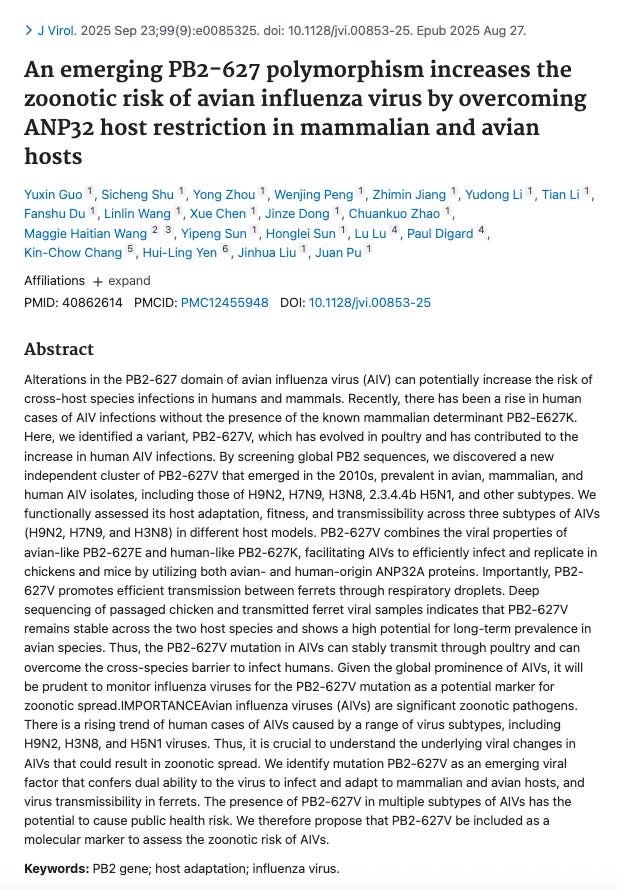This post was published by Jon Fleetwood. Please visit his Substack and subscribe to support his work. Follow Jon: Instagram@realjonfleetwood / X@JonMFleetwood / Facebook@realjonfleetwood
A September publication in the Journal of Virology confirms that Chinese and U.K. researchers have jointly created, enhanced, and tested new avian influenza “bird flu” viruses in the lab that acquired the ability to infect and spread among mammals through the air.
Congress, the White House, the Department of Energy, the FBI, and the CIA have confirmed that the COVID-19 pandemic was likely the result of lab-engineered pathogen manipulation.
Such experimentation raises national security and biosafety concerns.
Countries all over the world are performing risky experiments on bird flu viruses while developing drugs for the disease, simultaneously creating both the problem and the solution, raising questions about conflicts of interest and motives.
The new study—led by Dr. Juan Pu and Dr. Jinhua Liu of China Agricultural University—used a plasmid-based reverse-genetics system to construct synthetic viruses based on H9N2, H7N9, and H3N8 avian-influenza backbones.
The team intentionally introduced a new mutation called PB2-E627V, a single amino acid change that does not occur naturally in these strains, which allows bird flu viruses to cross into humans.
“Recombinant viruses were generated using a plasmid-based reverse genetics system in the genetic background of 17/H9N2, 17/H7N9, and 22/H3N8,” the authors wrote.


What the Mutation Did
The PB2-627V mutation bridged the species barrier between birds and humans by allowing the virus to exploit host proteins in both.
“PB2-627V combines the viral properties of avian-like PB2-627E and human-like PB2-627K, facilitating AIVs to efficiently infect and replicate in chickens and mice by utilizing both avian- and human-origin ANP32A proteins.”
In other words, the modified viruses replicated like avian strains in birds and like human flu viruses in mammals—a dual-host adaptation that overcomes the natural molecular restriction that normally prevents bird flu from establishing infection in humans.
Aerosol Transmission in Mammals
Perhaps most disturbing, the researchers infected ferrets—the most widely accepted mammalian model for human influenza—and documented respiratory-droplet (aerosol) transmission.
“PB2-627V promotes efficient transmission between ferrets through respiratory droplets.”
This means the engineered H9N2 strain became airborne and contagious between mammals, an outcome that squarely fits the U.S. government’s definition of “enhanced Potential Pandemic Pathogen” (ePPP) research under the HHS P3CO framework, which covers any experiment that enhances the transmissibility or virulence of a pathogen so that it is likely capable of widespread and uncontrollable transmission in human populations.
Replication in Chickens, Mice, & Humans
The study showed that the lab-created viruses replicated efficiently in chicken lungs, increased viral loads in human-cell cultures, and caused more severe pathology in mice than wild-type strains.
The viruses were also serially passaged through five generations of live chickens, proving that PB2-627V remains genetically stable and transmissible in poultr.
This means the mutation could sustain itself in farm flocks and later spill over to people.
“PB2-627V showed a high potential for sustained prevalence in chickens,” the authors concluded.
Funded by Chinese & British Governments
The paper lists funding only from China and the United Kingdom:
“This work was funded by the National Key Research and Development Program of China (2021YFD1800202 and 2022YFF0802400 [J.P.] and 2024YFE0106000 [J.L.]), National Natural Science Foundation of China (32192450 [J.L.] and 32102661 [Z.J.]), and UK Biotechnology and Biological Sciences Research Council BBS/E/D/20002173 and UK Medical Research Council MR/Y015045/1”
Collaborating institutions included the Roslin Institute (University of Edinburgh), the University of Nottingham, and the University of Hong Kong, alongside China Agricultural University in Beijing.
In plain terms: the Chinese and British governments jointly funded and executed gain-of-function experiments that engineered avian flu viruses to infect mammals through the air.
Biosecurity & Ethical Concerns
The authors admit that contamination occurred in sequencing samples, though they claim those data were “excluded from the final results.”
“Due to potential contamination identified in sequencing samples from the second and third parallel experiments during subsequent analysis, all data from these experiments were excluded from the final results,” the study reads.
That means while performing next-generation sequencing (NGS) on viral samples, the researchers detected contamination in some of their experimental batches—specifically, in the second and third parallel experiments.
Such an admission in a study manipulating airborne bird flu viruses underlines serious biosafety questions about laboratory conditions and oversight.
There is no mention of independent biosecurity review, P3CO-style oversight, or international ethics board approval for the gain-of-function component of the work.
International Risk
The paper acknowledges that the PB2-627V mutation is already spreading naturally across multiple subtypes—including H5N1, H5N6, H7N9, H3N8, and H10N3—and has been found in humans, foxes, minks, tigers, and wild birds.
The authors warn:
“Given the global prominence of AIVs, it will be prudent to monitor influenza viruses for the PB2-627V mutation as a potential marker for zoonotic spread.”
That is an understatement.
What they have demonstrated is that lab-modified avian-flu viruses can now infect mammals and transmit through the air—a benchmark for pandemic-capable pathogens.
Bottom Line
The Journal of Virology paper by Guo et al. (2025) provides direct evidence that:
- China and the United Kingdom jointly conducted gain-of-function experiments on avian flu viruses.
- The resulting strains crossed the species barrier and became airborne between mammals.
- These experiments meet the U.S. government’s definition of enhanced Potential Pandemic Pathogen (ePPP) research.
In short: Western and Chinese scientists have again created lab-made bird-flu viruses capable of infecting mammals through the air—exactly the kind of experiment international biosecurity laws were supposed to prevent.
Your support is crucial in helping us defeat mass censorship. Please consider donating via Locals or check out our unique merch. Follow us on X @ModernityNews.
More news on our radar





















I currently presently not at any point figured out like it’s far even conceivable yet one in everything about partner buddy made $27,000 best (r85) inside about a month essentially completing this smooth chance and moreover she has provoked me to benefit. forward-thinking data on visiting following
site… the site is mention in my name for more info